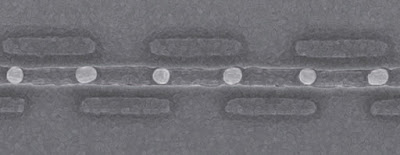 |
| An electron microscope image of a quantum simulator made from a 1D array of Josephson junctions (light dots). (Courtesy: Philip Krantz, Krantz NanoArt, adapted by APS / Alan Stonebraker) |
Topics: Modern Physics, Nanotechnology, Quantum Mechanics, Superconductors
A theory that describes how quantum particles interact with each other in 1D has been put to the test by two independent teams of physicists. In one experiment, aspects of the Tomonaga–Luttinger theory were verified using laser-trapped ultracold atoms. The other study made use of superconducting devices. Confirmation of the theory could lead to the development of new technologies based on nanowires and other 1D systems. Applications include electronics, sensing, energy harvesting and quantum information.
Tomonaga–Luttinger theory describes a 1D ensemble of interacting quantum particles in terms of a Tomonaga–Luttinger liquid (TLL). It predicts properties of 1D quantum systems such as how electrons behave in a nanowire. Testing these predictions in a systematic way has not been possible, however, because it is very difficult to control how particles interact in 1D systems such as nanowires.
Atoms and Josephson junctions simulate 1D quantum liquid, Hamish Johnston, Physics World
Comments